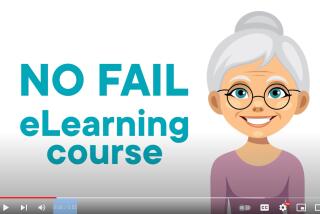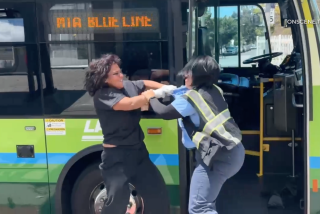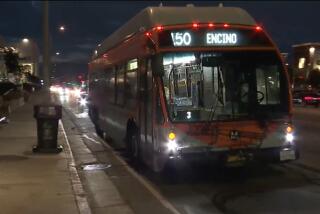6% of 431 Drivers Fail Latest RTD Drug Tests
- Share via
Interrupting what top officials had predicted would be a steady downward trend, more than 6% of Southern California Rapid Transit District bus drivers tested last month were found to have used drugs.
Tests on 431 bus operators during September found that 6.26%, or 27, had drugs in their systems. In August, when the district tested 288 drivers, the positive rate had been 4.5%--a figure repeatedly cited by RTD officials as evidence that the district’s year-old anti-drug program is curbing the problem. The rate had been as high as 21% in the first two months of the program last year and averaged about 11% in the first 12 months ended in August.
For most of that year, the rate bumped up and down between 7% and 15%. The jump between August and September could be another temporary aberration, except that officials had said they hoped to see an unbroken downward trend.
“This is not at all the direction I’d like to see it move,” said RTD General Manager John Dyer, who recently told the agency’s board of directors that he expected a smaller and smaller share of drivers to be found using drugs.
New Tests Not Yet in Effect
The new figures represent the largest group of drivers tested in several months, but they do not reflect toughened drug-testing standards that were adopted by the RTD board Aug. 29 after widely publicized accidents involving drivers who had drugs in their system. The new testing practices are not yet in effect.
Generally, those practices mean that more drivers will be tested, including those involved in less serious on-duty accidents--with injuries or damages under $1,000--and those who are repeatedly tardy or absent. The current policy requires testing when drivers are given biennial physical examinations, are involved in accidents involving $2,000 damage and up or display erratic behavior.
Field supervisors are still being trained in how to apply the new policy and implementation is expected in the next few weeks, officials said.
Of the 27 bus drivers who tested positive last month, 10 tested positive for marijuana and six for cocaine, with the remainder for alcohol and a variety of other drugs, including those obtained through prescriptions.
Thirty-two drivers tested had been involved in accidents and of that group, three tested positive for drugs, and one of those three was fired. The other two apparently were allowed to enter the district’s drug rehabilitation program. Under the current drug policy, those testing positive for marijuana use are not automatically fired.
Dyer said the larger number of drivers tested last month shows that, even before the new policy takes effect, “the drug policy is being enforced more intensively by field supervisors.” And despite the increase, he said, the overall trend “is certainly down.”
Goldy Norton, a spokesman for the bus drivers’ union, said: “I just think there are . . . a certain number of drivers who don’t have the good sense to stop screwing around with these (drugs).
“There are idiots out there--no matter what you do--who will risk their life and livelihood. We do everything we can to make sure they don’t mess around with their futures,” Norton added.
More to Read
Sign up for Essential California
The most important California stories and recommendations in your inbox every morning.
You may occasionally receive promotional content from the Los Angeles Times.










